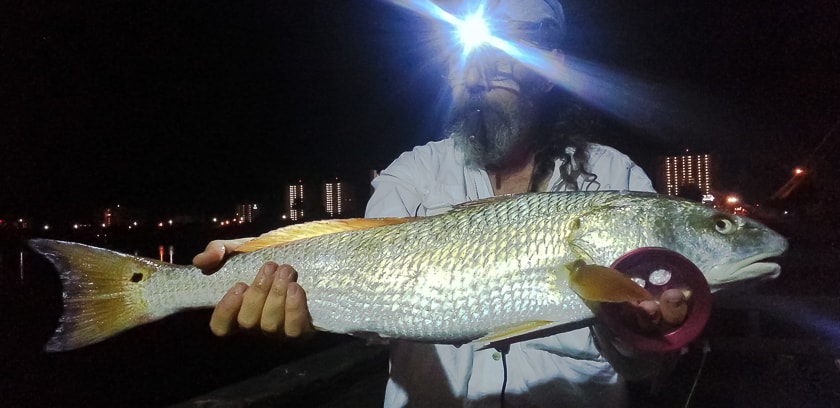It was a slow summer night, the air was thick and the breeze was not strong enough to keep the no-see-ums at bay. Around 2 am on a Sunday night, the pier was almost empty. This particular location is only a couple of miles from the inlet, so I figured it was not a bad spot to try our luck. But, at this point, it was not looking very promising. We had been soaking bait for almost four hours, and so far we only had a couple of mangroves, catfish, a croaker and a ladyfish we used for shark bait, to show for our effort. My lovely wife and I started talking about packing it up since we had an almost two-hour ride to get home and we had a long list of stuff to do on Monday.
That is when all of the sudden, the Yoyito reel jumped and the line started to go out, even though I had wrapped it around the railing of the pier three times. I knew it was a decent size fish, but given that I was in about 10 feet of water and there was still a bit of current I assumed it was a Sail (gafftopsail catfish). I started to retrieve the line, winding it directly onto the Yoyito and taking my time but making sure I don’t allow the like slack too much. I didn’t have much line out, may be 40 yards, but he took another 20 on the first run so at that point I started to wonder what it could be. I told my wife that it felt like a Jack because it keeps sounding and pulsating on the line like the Jacks usually do. A few minutes later, to my surprise, I finally see it through the cloudy waters of the Halifax river. It was a Red and a pretty nice one too! The funny thing is that it was the wrong location, the wrong bait and the wrong rig for a red, yet here it was.
Handlining for Reds
As you can see from the story above, you never know what may come out of the water, but there are specific techniques for reds to do work best with handlines. Although you can, and I have, fished with artificials, live or cut bait is much easier to do when you are handlining. I want to relay my experiences to the folks that are starting out or have recently rediscover the ancient art of handlining.
I’ve used blue crabs, finger mullets, oysters, and shrimp. But probably more reds have been caught on live shrimp than anything else. My favorite way to fish with live shrimp is to float them on a weighted bobber, allowing me to cast them about 30 yards. Normally I’m in the shallows on my kayak and I’m looking for tailing or other signs and I just cast past the fish and retrieve slowly. The leader is usually no more than 12 inches, I’m fishing only a couple of feet of water that tends that be full of oyster beds and longer leader just means losing bait against the oyster beds. If I don’t see any signs of reds, I’ll just paddle slowly around the area trolling my bobber about 30 yards behind the kayak, with the reel in my PFD pocket, trying to avoid making noise with my paddles or by banging them against the boat.
The action is fast, sometimes explosive, but after the first run, they are not much different than any other fish. I do recommend circle hooks between 1/0 and 4/0 and hooking your shrimp through the horn, carefully avoiding their brain or any vital organ (they’ll stay alive longer this way). Circle hooks minimize gut hooked fish, something especially important since you are only allowed to keep fish between 18″ and 27″, ensuring a higher probability of releasing the fish unharmed. But these hooks are also better for handlining, because once they are in, they seldom come off and you can take your time reeling in the fish. Reds can be quite large, so make sure you give them line when they pull, you are the drag system when handlining. If you hand on too hard, the line will snap and you’ll loose the fish. Try practicing by tying the line to something solid and pulling on it, so you get a feel of how much force it takes to break the line, then make sure you only pull about half of that when you are fishing a fish.
Good luck with those reds and please send us pictures or videos if you catch one on a handline.


